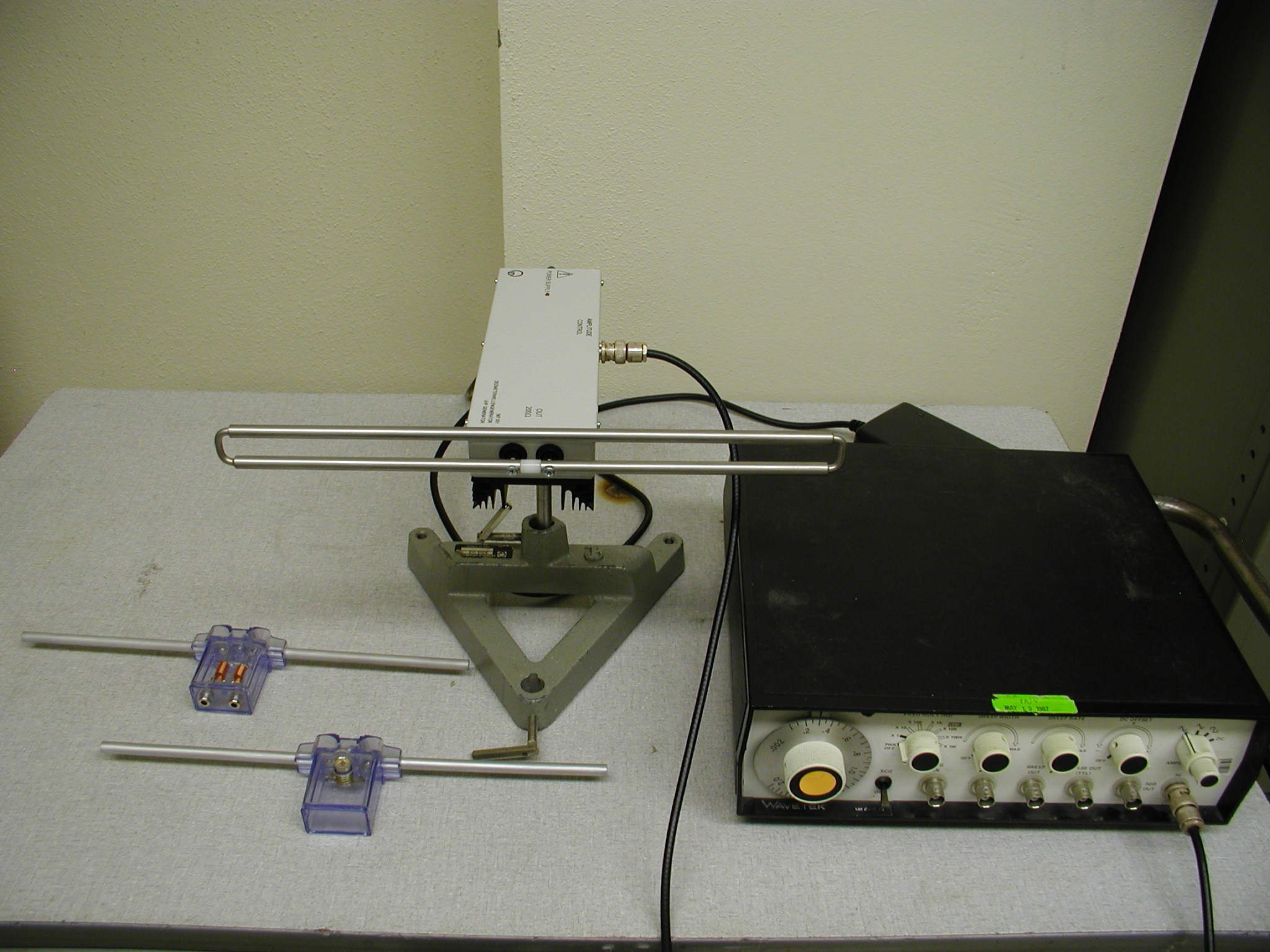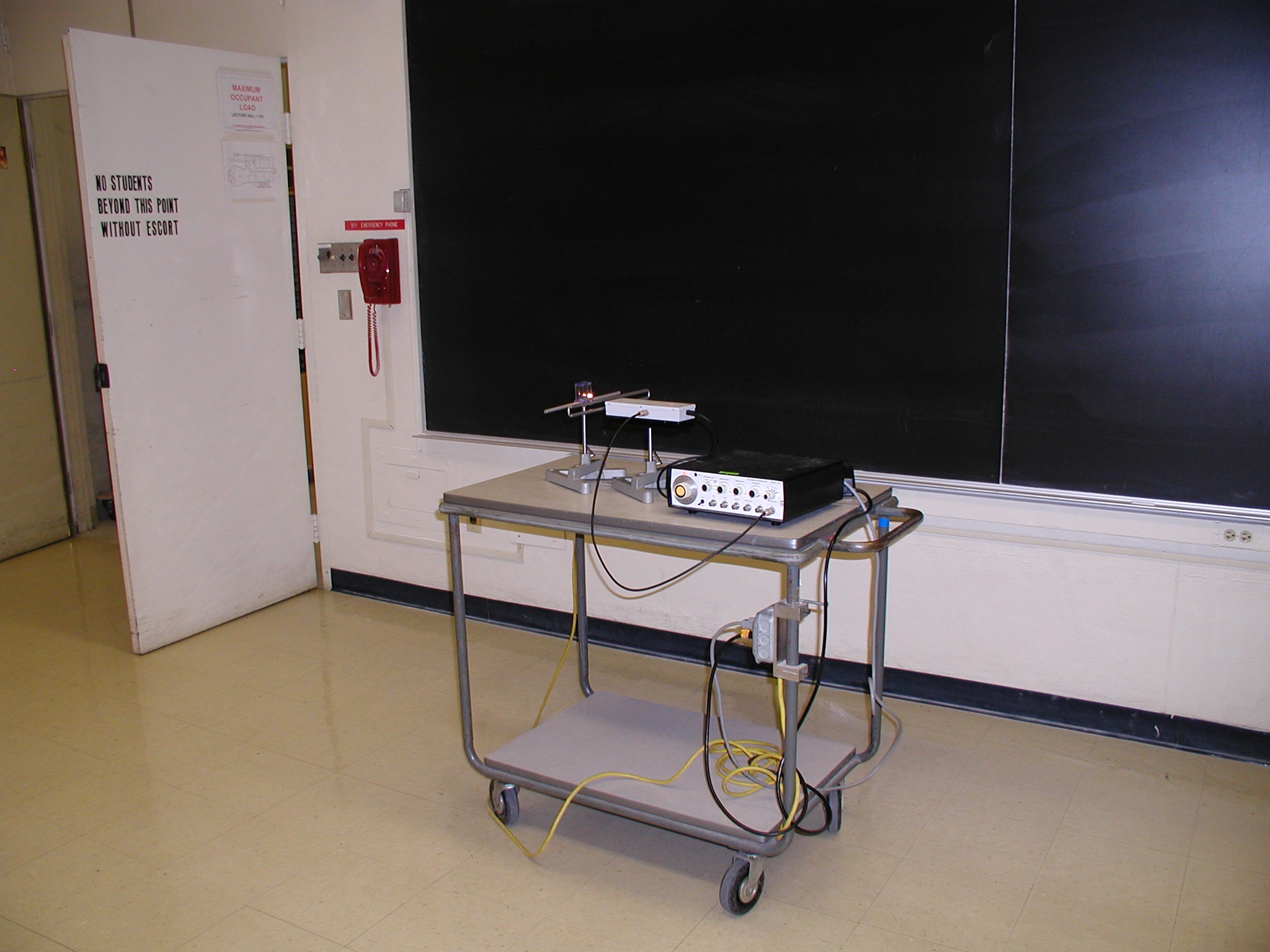| Physical Principles: Electromagnetic Waves - Polarization and Propagation through physical media. |
| Student Prerequisites: For this demonstration, students need to be familiar with the two basic properties of any EM wave - a.) the orientation of the electric field associated with the wave determines its polarization, and b.) the wavelength and speed of propagation of the wave through a physical medium are reduced compared to the corresponding values in vacuum. |
| Introduction: The all - pervasiveness of EM waves is evident from the fact that they need to be dealt with in diverse applications - antenna design for communications, the study of optical media for fiber optical links/channels, and studies of the interaction between EM waves and human tissue in medicine, to name just a few. This plethora of subject areas that require a basic understanding of the EM wave characteristics demonstrated in this experiment,make it useful to students aiming to specialize in a number of different areas of Science and Engineering. In this experiment, students will use their understanding of propagation through media to make a qualitative prediction about whether the length of receiver required to detect a wave propagating through water is more or less than what is required to detect the same wave propagating through air, given that the length of transmitter and receiver are directly proportional to the wavelength of propagation. Next, students will apply Malus' law to make a qualitative prediction about the change in intensity of the wave when the receiver is oriented at different angles relative to the transmitting antenna.
The primary objective of this interactive demonstration is to use a rather sophisticated, yet readily recognizable device (UHF transmitter and receiver) as a means to demonstrate how the basic properties (polarization and propagation) of any EM wave are strongly dependent on the conditions under study (medium of propagation, distance between transmitter and receiver, orientation of receiver etc.).
|
Description of the Demo: The product of the frequency and wavelength of a wave propagating through a medium equals its speed of propagation:
This is the fundamental equation relating the frequency and wavelength of a wave to its speed of propagation in a particular medium. For a given frequency, the wavelength and speed vary with the medium of popagation.
The light bulb on the receiving antenna lights up when resonant absorption occurs, the condition for which is:
Using equation (2) above, the wavelength of propagation in a given medium can be found if the length of the receiver is known.
In addition to the medium of propagation and the length of the receiver, the spatial orientation of the receiver is also an important consideration for most applications. The distance away from the transmitter and the angle of the receiver relative to the transmitter determine the intensity of radiation detected - the maximum intensity is received for the case when the receiver is oriented parallel to the transmitter and very close to it.
|
| Instructions: The UHF transmitter produces decimeter waves at a frequency of 433.92 MHz. Modulation is provided externally with a function generator. A good modulating signal to use is a sinewave at audio frequencies (e.g. 300 Hz, set by turning the main dial on the function generator to 0.3, and setting the "Freq Mult (Hz)" dial to x1KHz).
The first part of the experiment involves getting the students to predict, using equation (1) above, whether the wavelength an EM wave increases or decreases relative to air, when the wave propagates through water. The half - wave antenna setups in air and water may then be used, along with equation (2) above, to demonstrate to students that since it is the light bulb on the shorter antenna that lights up in water, the wavelength of the UHF wave must indeed decrease in water.
 
The second part of the demonstration involves studying polarization effects. The longer receiver dipole with light bulb can be used to demonstrate to students that reception is best when the receiver dipole is held parallel to the transmitting dipole. Students can be asked to predict, using Malus' law (equation (3) above), how the intensity of the light bulb on the receiver will be affected when it is rotated and held at 45 degrees relative to the transmitting dipole. The receiver dipole may then be gradually rotated relative to the transmitting dipole until the light bulb goes out completely at a 90 degree position. Students may also be shown how the intensity of the light bulb is affected when the receiver is moved farther away from the transmitter, and close to the ends of the transmitting dipole.
|
| Notes to the Instructor: 1.) A calculation of the length of each dipole using equation (2) above yields a slightly different value from the actual lengths. This is because the estimation of wavelengths from lengths of dipoles and vice versa using equation (2) is only approximate and does not account for the finite diameter of the Hertzian dipole.In addition, the resonance condition is affected by the built - in light bulb. 2.) The first three CPS questions are intended to help students work toward the predictive parts of the demo, which are contained in the last three questions. The instructor may choose to simply remind students of the basic concepts contained in the former, and proceed to use one or more of the latter as "clicker" questions that can be supported with demonstrations. |
| Possible CPS Questions:
1. What is the transmitted wavelength in air... [Question] [Answer]
2. What is the speed of propagation through water... [Question] [Answer]
3. What is the wavelength of propagation through water... [Question] [Answer]
4. Which receiving antenna is suitable or each medium... [Question] [Answer]
5. What is the optimum orientation of the receiving antenna... [Question] [Answer]
6. What happens if the receiving antenna is rotated to a 45 degree position... [Question] [Answer]
|
|
|
Page created by Ravi Raghunathan, Dept. of Physics & Astronomy, University of New Mexico.
|
|